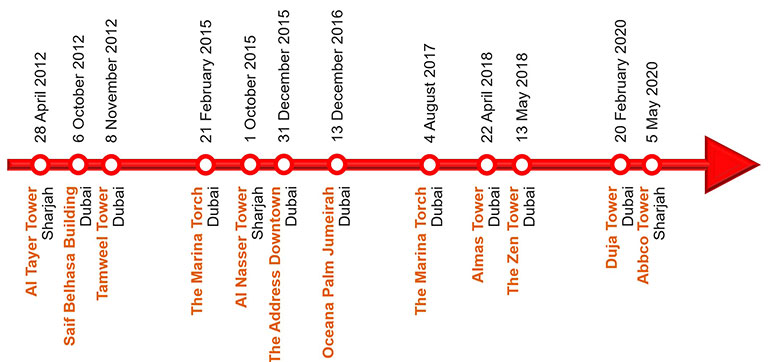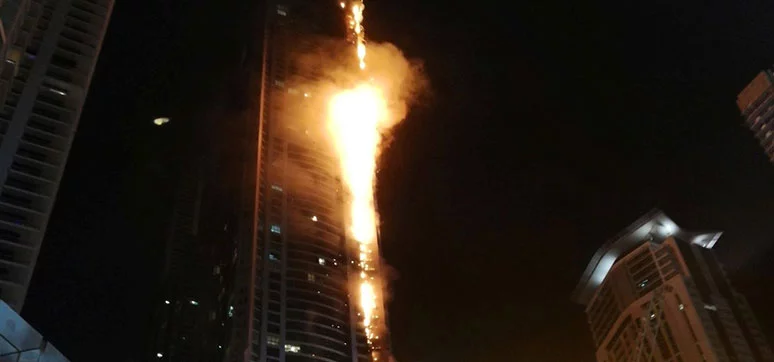BACKGROUND
There have been numerous fires involving buildings with combustible cladding not just in the United Arab Emirates (UAE) but internationally. In most cases, the extent of damage to the building has been significant, and unfortunately in a few instances, there has been the loss of life. The consequences of such fires are extensive where occupants are displaced and need to seek alternative accommodation. There can also be disputes over the rebuilding costs and who is responsible especially where buildings have multiple owners and tenants. Insurance companies are getting more aware of such risks and may refuse to provide cover or raise premiums substantially due to the increased fire risk.
THE UAE FIRE AND LIFE SAFETY CODE OF PRACTICE
The applicable building fire code in the UAE is the “UAE Fire and Life Safety Code of Practice” which is developed by the UAE General Headquarters of Civil Defence. This code was originally released in 2011 and was primarily based on NFPA codes and standards as well as local practices. It did not contain any specific requirements on façades, however, where the code was silent on any fire safety aspect reference was normally made to relevant NFPA codes and standards. Between 2012 to 2014, additional Annexures were released which contained guidance and additional requirements for façade systems. The code was updated in 2017 and more recently in 2018 to include specific requirements for each type of façade system. The current 2018 edition of the UAE Fire and Life Safety Code of Practice has specific requirements for façade fire assessment and inspections. It requires the façade design to be reviewed by a competent, qualified, and approved fire consultant before any installation of the façade at the site.
QUALIFICATION AND LICENSING
The technical qualification and registration are essential to verify the competency and to ensure the individual or organization is competent, qualified, licensed, and can be accountable for the design and installation of the façade assembly.
As per the UAE Fire and Life Safety Code of Practice the minimum requirements are as follows:
• Cladding supplier must be registered and licensed with Civil Defence
• Cladding system must be tested and certified by an accredited testing and certification body
• Cladding system must be registered and licensed with Civil Defence
• Fire consultant reviewing the façade design and inspecting the façade installations must be registered and licensed with Civil Defence (i.e. House of Expertise)
• Façade installer must be registered and licensed with Civil Defence
• Façade installer must be trained and certified by the cladding system supplier
FAÇADE DESIGN REVIEW
A façade fire assessment report is required to be submitted by the House of Expertise to Civil Defence ideally prior to any installation of the façade onsite. This report outlines the façade assembly proposed for the development and incorporates the system schematics. Some of the key components of this report include:
• Description of the building including occupancy type, height, stakeholder’s details, etc.
• Building elevation highlighting the different types of façade systems and the extent of each on the building façade.
• Workshop drawings and schematics of the different façade systems indicating the various components that form part of the system.
• Reaction to fire test: each component of the façade to be fire tested (exposed without the skin). •
Full-scale assembly test: the complete façade assembly system to be fire tested.
• Spandrel separation: vertical (minimum 915 mm) or horizontal (minimum 760 mm) 1-hour fire-resistance-rated spandrel separation is required for buildings more than 15 m in height, even in fire sprinkler protected buildings.
• Perimeter fire barrier: certified and listed system to be provided at the slab edge.
• Cavity fire barrier: to be provided at each floor level within the void space between the cladding and primary substrate and around façade openings (e.g. windows).
The UAE Fire and Life Safety Code of Practice have specific small- and full-scale fire testing requirements for various type of cladding systems. It provides options for testing to American, British and European standards with minimum acceptance criteria depending on occupant and building classifications.
Any deviations from the tested, certified, and listed system requires an Engineering Judgement (EJ) by an accredited testing and certification body. Undertaking letters from all the relevant stakeholders are required to be provided to confirm the system performance, design and installation will be as per the UAE Fire and Life Safety Code of Practice.

FAÇADE FIELD VERIFICATION
Once the façade fire assessment report is approved by Civil Defence and installation of the façade commences at the site; field inspections must be undertaken at every 20% interval as a minimum to verify the façade installation. This applies to the façade assembly including the cavity fire barriers where provided.
The perimeter fire barriers are required to be inspected as per ASTM E2393 Standard Practice for On-Site Inspection of Installed Fire Resistive Joint Systems and Perimeter Fire Barriers (i.e. 1 destructive test for every 152 linear meters.
The inspection is to verify the as-built condition against the approved façade fire assessment report. If there are any deviations this must be highlighted and may need rectification works or resubmission of the façade fire assessment report to the local Civil Defence.
The House of Expertise undertaking the field inspections shall be accredited to ISO 17020 Conformity assessment – Requirements for the operation of various types of bodies performing an inspection as an independent third-party special inspection agency.
WAY FORWARD
The understanding of façade fires and risk is evolving, and we must continuously learn and improve our knowledge on this subject.
The current approach in UAE to mitigate façade fire risk in tall buildings is applicable for new construction. It has been progressively updated over the last 10 years with the latest developments, new fire test standards, and lessons learned from façade fires locally and internationally. The UAE Fire and Life Safety Code of Practice currently provides the most comprehensive prescriptive guidance on the façade fire performance internationally. It can be considered as the minimum benchmark for prescriptive compliance. Some of the key benefits of this prescriptive compliance approach are:
• Easy to apply and review the façade fire performance which makes the approvals process much smoother.
• Façade fire assessments are consistent and not generally subject to interpretation.
• The process does not just consider design review but extends to field verification to confirm the as-built condition is no different from the approved design.
• Minimum competency and qualification requirements are clearly outlined for each stakeholder, including their roles and responsibilities.
• Responsibility for a compliant façade assembly design and installation is shared by all the stakeholders including consultants, contractors, cladding system supplier, fire consultant (House of Expertise), etc.
At this stage, the UAE Fire and Life Safety Code of Practice does not consider existing buildings. It would be beneficial to introduce a mechanism to assess existing building cladding. Further, the Code currently does not have provisions for assessing or including any new or innovative materials or façade systems. Compliance with the prescriptive provisions does not mean a façade fire will not happen. However, prescriptive compliance does reduce the likelihood of façade fires to the scale experienced with The Address Downtown (Dubai), The Marina Torch (Dubai), and Grenfell Tower (London). For a holistic approach, it is recommended to undertake a façade fire risk assessment in addition to prescriptive compliance to understand the specific fire and life safety risks for each building.














